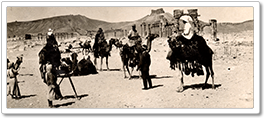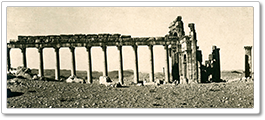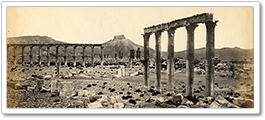by Norbert Schiller
I had the privilege of visiting the ancient Roman city of Palmyra twice; the first time was in the middle of summer and the second was in the dead of winter.
My first visit to Palmyra was when I was traveling with a group of journalists from Qamishli, in the very northeastern corner of Syria, to the capital Damascus. The bus journey was some 10 hours long, and, as a way to break up the monotony of the trip, the government minder accompanying us decided to stop in Palmyra for a short break. The break extended into a longer visit when the minder realized that many members of the group had ever been to the site. When we stepped off the bus, it was like walking into a furnace as the sun pitilessly beat down on us. However, because the weather is dry in this part of the desert, it was bearable enough to go out and explore.
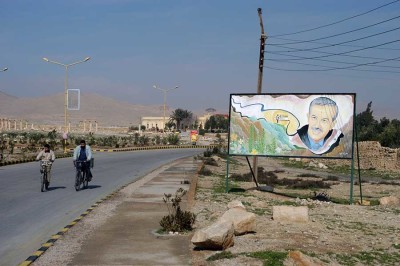
A mural of Bashar el Assad’s father, Hafez al Assad, near the entrance of Palmyra. Phot. Norbert Schiller
My biggest dilemma was where to go first. As a photographer I wanted to capture everything in our short time there, so I grabbed my camera bag and started running through the ruins looking for the best angles to photograph. Suddenly, I felt so overwhelmed by the sheer enormity of the place that I stopped dead in my tracks, took a deep breath, and told myself to calm down. Palmyra was not going to run away. I could always come back at a later date when I wasn’t so rushed and capture the true essence of the city at my own pace. In the end, I relented and joined the rest of the group as they toured the ruins admiring their magnificence and solitude.
My second trip was nearly a decade later, while I was working with a writer on an economic report about Syria. We arrived at the historic Zenobia hotel, located just beside the ruins, well after dark. Over the previous week, we had been racing around the country covering everything from the economy to industry, with little time to spend in any particular place. However, when we arrived in Palmyra we decided to make an exception and spend at least the first half of our first day exploring the ruins, before moving on to our next destination.
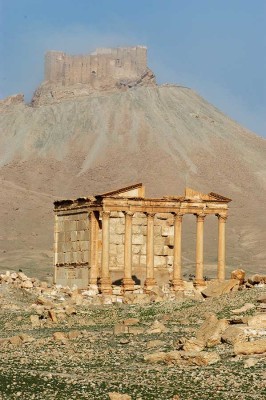
Fakhreddine al Maany Castle overlooks the ruins of Palmyra. Phot. Norbert Schiller
The following morning we woke up before dawn and, when we stepped outside, all we could see was the tops of the Roman columns floating above the mist. In the distance, partly obscured by the early morning haze, was the Fakhreddine al Maany Castle perched high on a hill. Unlike my previous trip, this time I felt the biting cold of the January desert temperatures and had to keep moving to stay warm. As the sun rose, the mist lifted and before long the ancient city revealed itself in all its wonder. The timeless beauty of Palmyra is perhaps best described in H.V Morton’s book, Through Lands of the Bible:
“Everywhere rose the remains of Palmyra, a great arch, temple, broken pavements: a ghostly city lying in a golden desert. Sometimes when you are traveling in the desert…you come across the skeleton of a camel lying in the sand. Palmyra is like that: a long Hellenistic back-bone, which is the main street of Columns, and ribs leading off to the right and left; a ruin picked clean by time and bleached by the sunlight for centuries to the colour of pale honey.”
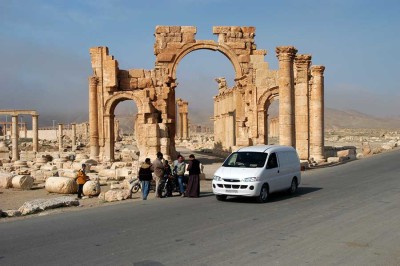
A car with visitors stops alongside the Arch of Triumph. Phot. Norbert Schiller
We spent the better part of the morning exploring Palmyra’s magnificent ruins, which are the last remaining testimony of a once flourishing city that linked Persia to ports along the Mediterranean. Strangely, there were no other visitors in this spectacular and once prominent site, except for a few local Bedouins who made their living selling small handicrafts and semiprecious stones to tourists. It wasn’t till the early afternoon, as we were about to leave, that I noticed a car carrying three people pull up to the site. As we passed them, I felt as though we were handing over the keys to the ancient city to the next travelers to enjoy their own private moment among the ruins.
Even though I took more and better photos than on my previous visit, I didn’t see this trip as a photo-op, but rather as another opportunity to wander through the site and take in its magic. I was sure I would be back again to capture Palmyra’s splendor once more, on film. However, like many who have fallen under the spell of Palmyra, I fear that my next visit will bring more distress than enjoyment.

